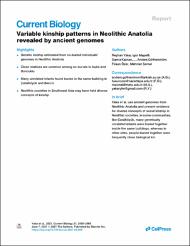Künye
Yaka, R., Mapelli, I., Kaptan, D., Doğu, A., Chyleński, M., Erdal, Ö. D., Koptekin, D., Vural, K. B., Bayliss, A., Mazzucato, C., Fer, E., Çokoğlu, S. S., Lagerholm, V. K., Krzewińska, M., Karamurat, C., Gemici, H. C., Sevkar, A., Dağtaş, N. D., Kılınç, G. M., … Somel, M.. (2021). Variable kinship patterns in Neolithic Anatolia revealed by ancient genomes. Current Biology, 31(11), 2455–2468.e18. https://doi.org/10.1016/j.cub.2021.03.050
Özet
The social organization of the first fully sedentary societies that emerged during the Neolithic period in Southwest Asia remains enigmatic,1 mainly because material culture studies provide limited insight into this issue. However, because Neolithic Anatolian communities often buried their dead beneath domestic buildings,2 household composition and social structure can be studied through these human remains. Here, we describe genetic relatedness among co-burials associated with domestic buildings in Neolithic Anatolia using 59 ancient genomes, including 22 new genomes from Aşıklı Höyük and Çatalhöyük. We infer pedigree relationships by simultaneously analyzing multiple types of information, including autosomal and X chromosome kinship coefficients, maternal markers, and radiocarbon dating. In two early Neolithic villages dating to the 9th and 8th millennia BCE, Aşıklı Höyük and Boncuklu, we discover that siblings and parent-offspring pairings were frequent within domestic structures, which provides the first direct indication of close genetic relationships among co-burials. In contrast, in the 7th millennium BCE sites of Çatalhöyük and Barcın, where we study subadults interred within and around houses, we find close genetic relatives to be rare. Hence, genetic relatedness may not have played a major role in the choice of burial location at these latter two sites, at least for subadults. This supports the hypothesis that in Çatalhöyük,3–5 and possibly in some other Neolithic communities, domestic structures may have served as burial location for social units incorporating biologically unrelated individuals. Our results underscore the diversity of kin structures in Neolithic communities during this important phase of sociocultural development.
Kaynak
Current Biology
Cilt
31
Sayı
11















